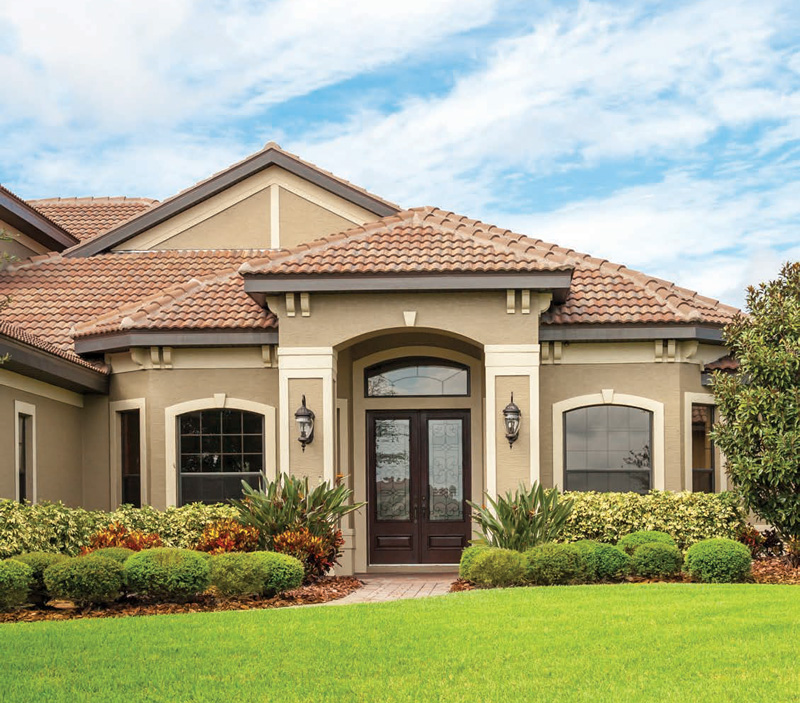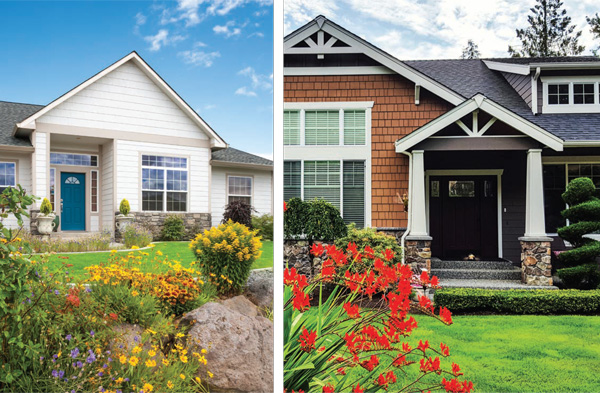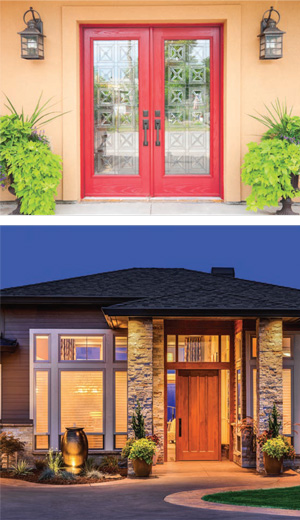
With most of our time at Smith Mountain Lake spent on or around the water, focus on the front entrance of our homes tends to get lost. It’s no wonder: With the wonderful distractions the lake holds, it’s easy to overlook an area that doesn’t see much more than basic comings and goings. It’s easy to forget that the front yard is part of the greater neighborhood landscape, and helps create the transition from public to private space. Giving this area a little bit of attention goes a long way toward creating a beautiful expression of welcome to your family and guests.
The shape of hardscape
Start with the view from the street. The driveway is the first official entrance, so make it memorable with plantings. You’ll want the space to be easy to maneuver in and out of, so don’t plant anything too large. Tall planters filled with blooming annuals offer a festive greeting. Shrubs—either evergreen or something blooming like an azalea or rhododendron—make for a more formal appearance. Or go with something like an ornamental grass for a more dramatic statement. Be sure the house number is displayed clearly at the entrance for the convenience of visitors, whether it be on a post or pillar devoted solely to that purpose or incorporated onto the mailbox.
And speaking of the mailbox: It needs to be easy to access, but it should also blend with your surrounding landscape. Plantings around the base help soften it, particularly something with some height, but not tall enough to obstruct using the mailbox. If possible, whatever is planted around the mailbox should fit into your greater landscape plan, but could also just be a few pots of blooming annuals at the base. A small hanging planter of trailing petunias, hung from underneath the mailbox, is an unexpected and charming way of softening the appearance of the post. Keep in mind you’ll need to water whatever you plant, so be sure you’re able to access it easily with either a hose or watering can.

A pretty path
It is important for pathways leading to and around your home to be easy to navigate, while also being welcoming. They may be utilitarian in purpose, getting you from one place to another, but they also help set a tone for the entry into the house. A straight path leading up to your home points attention directly to the front door, while a more curving path encourages one to slow down and take in the surroundings. Maintaining your path, so that it’s clean and in good repair, is helpful for attractiveness as well as safety. A stone, brick or concrete paver walkway, laid in a stepping stone manner with ground cover planted in between is both informal and charming, creating a lush appearance that is easy to maintain. A low creeping perennial keeps better than mulch or pea gravel, won’t need regular mowing, and can help crowd out weeds. If you do go with a ground cover plant between stepping stones, there are a number of hardy specimens to choose from—moss, creeping thyme, creeping Jenny and a variety of creeping sedums. Choose the one that will be best suited to traffic and sunlight patterns in your yard.
These same ground cover plants can also be used to create definition to the edges of your pathway, softening the edges while blending it into the surrounding landscape. If you prefer more definition or something taller, consider lamb’s ear, liriope, lavender, or a perennial geranium—all low-growing, hardy, attractive and easy to care for. Shrubs could also be planted, creating a more formal appearance, but will need to be maintained to avoid crowding the path over time.
 Light the way
Light the way
Lighting is another important consideration for our front paths and entries. Solar lanterns set along a path, a few inches above the ground, are an easy and inexpensive option without being too obtrusive. If there are any steps or grade changes on your path, you’ll want to be sure you have some sort of light illuminating them at night for safety. Uplighting architectural features on your home can be lovely, but downlighting is the best method for safely illuminating walking paths at night. When choosing light fixtures for nighttime walking safety, be sure to choose fixtures that shed their light down and out. Downlights placed high in trees can be used to illuminate an entire area, giving a softer glow than a floodlight on the side of a house or other building.
Tie your home into the surrounding landscape with some plantings around the foundation. Foundation plantings help soften the appearance of a home, giving it a sense of belonging. These plantings aren’t limited to shrubs; a combination of shrubs, ground covers and small trees makes for a more interesting look. Care must be taken when planting close to the house; a good rule of thumb is to consider half the expected mature spread of the plant for determining the planting distance. For example, a bush that could grow eight feet wide should be planted about four feet from the house.
Annual appeal
With the basics covered, annuals can be used to add bright pops of color in your front yard. Window boxes, hanging planters or other porch and front step container gardens add color and charm while helping give a lush appearance. Geraniums, begonias and impatiens are hardy blooming annuals that can hold their own during a dry spell, tolerate sun or some shade, and will bloom from spring straight through to the first frost of fall.
Annuals can be planted individually, or grouped together for a spectacular display. While there is something classic and welcoming about a single geranium in a pot, the interest of a several annuals planted together cannot be beat. When creating a container garden, go for a variety of heights and colors. Place a taller plant in the center—an ornamental grass, coleus or tall blooming plant like salvia—and surround it with a hardy blooming plant, like a begonia, smaller coleus, petunia, or heliopsis. Tuck a trailing plant or two— sweet potato vine or petunia—along the edge, to give a cascading effect.
Welcome home
All of this leads up to the primary focal point: the front door. A fresh coat of paint in a bright color can make a great statement. Consider something fun and unexpected like school-bus yellow. Or orange, purple or bright blue! Contrasting it with the other colors in your exterior palette will set it apart and distinguish it from the street. A wreath or hanging swag on the front door adds a welcoming, homey touch, as does a cheerful welcome mat. Displaying the house numbers clearly near the door is also helpful for visitors. There are many options available for house numbers, including individual numerals in traditional, script or modern fonts and address plaques in any manner of finishes. For a polished appearance, coordinate the finish of your house numbers with the hardware on the front door. It’s the details that help pull a look together.
The most important aspect in all of this is going for low maintenance items. It is, after all, the lake. And you’re not there to spend hours doing yardwork every weekend; you’re there to enjoy the tranquility of the lake. However you wish to personalize the front entrance of your home, consider it the red carpet of your lake house—both announcing and welcoming you and your guests to your home.
